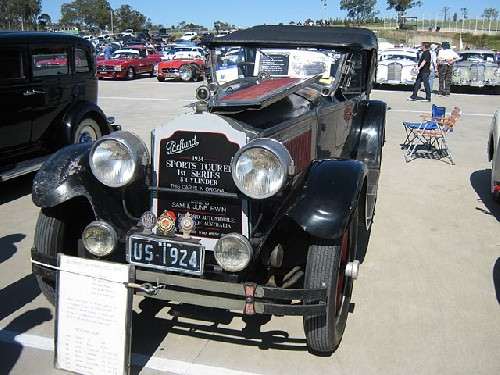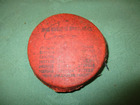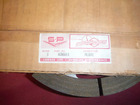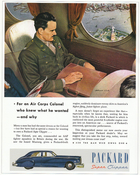|
Re: Larry's 1951 Club Sedan Project
|
||||
|---|---|---|---|---|
|
Home away from home
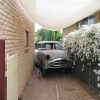
|
Thanks Owen, I feel a little more positive about the (eventual) registration getting approved!
I remember reading your post regarding some cars sitting around for perhaps a year awaiting finalization of the build. That would skew the figures slightly for Packard model imports in a given year I guess. Do figures exist that state the actual numbers of Packard imports into Australia, or have they been lost? Could I find out how many 2465's / 2495's came into Oz in 1951 (and 1952)?
Posted on: 2010/1/17 6:43
|
|||
|
1951 Packard Club Sedan | [url=ht
|
||||
|
||||
|
Re: Larry's 1951 Club Sedan Project
|
||||
|---|---|---|---|---|
|
Home away from home

|
Now I am experiencing a more positive feeling about the project, because I am fairly advanced with the initial stages of a full bare-metal restoration.
Here are just a few shots of how the car looked several months ago, around September 2009. My biggest problem (as most 24th series owners would agree) is the considerable rust in rear floors, in sills and rear mudguards (fenders). The car, before any bodywork was started . . .  Reasonably bad rust in the rear floors, adjacent to the Coupe rear windows. This is a known problem, there is a manufacturers kit which was retrofitted to Club Sedans to reduce the ingress of water. See Section XIX of the Service Manual (Fig. 65 relates).   Here is a mystery hole - This square opening has been cut into the LH side of the transmission tunnel, and I don't know why. (The other rounded hole was apparently cut by previous owner to mount body on a rotisserie). I have had it covered and welded so am hoping it was just a 'short cut' someone created to get to a linkage etc. If I need to 'reopen' it I can do so. If anyone has an idea as to why it was put there then I'd appreciate your thoughts!  Here the car is loaded and ready to go off to be blasted. The drivers side quarter panel rust can be seen here, it is about as bad as on the passenger side (RHD car).  I had considered chemical stripping, that would have been nice to do, but the cost is high. The company I spoke with said they could not fit the entire shell into their tank, nor the chassis (frame). Also, I would have needed to transport the car a considerable distance. After a lot of head-scratching and getting opinions from people, I chose blasting, but not of the turret, boot lid (trunk lid), guards and doors. All these I have manually stripped using paint stripper and stripper discs. I had many bits and pieces blasted, including wheels, brake drums, petrol tank. The chassis (frame) was done separately. Body and frame were media blasted and primed (excepting front fenders, hood and trunk lid, which were chemically stripped and cleaned to avoid any risk of distortion). Here the chassis is loaded and ready to be blasted. Close-up of the finish achieved.  Special trolley made up to sit the body on while it is repaired. This has proven invaluable, as I can proceed with work on the chassis while the body is being repaired.  Here are some views of the body, mounted on the 'trolley' I made for it, and ready for repairs at the metalworker's shed.   
Posted on: 2010/1/17 7:10
|
|||
|
1951 Packard Club Sedan | [url=ht
|
||||
|
||||
|
Re: Larry's 1951 Club Sedan Project
|
||||
|---|---|---|---|---|
|
Forum Ambassador
|
Quote:
Larry51 wrote:.....Do figures exist that state the actual numbers of Packard imports into Australia, or have they been lost? Could I find out how many 2465's / 2495's came into Oz in 1951 (and 1952)? Probably if anyone might know it would be Sam Irwin. Sam has an extensive collection of Packard records and literature and if doesn't know or if he can't find out then it's not available. Sam's number is (02) 9419 6617, tell him I pointed you in his direction, and be prepared to spend an hour or two on the phone, at least!
Posted on: 2010/1/18 2:38
|
|||
|
Mal
/o[]o\ ====  Bowral, Southern Highlands of NSW, Australia "Out of chaos comes order" - Nietzsche. 1938 Eight Touring Sedan - SOLD 1941 One-Twenty Club Coupe - SOLD 1948 Super Eight Limo, chassis RHD - SOLD 1950 Eight Touring Sedan - SOLD What's this?  Put your Packard in the Packard Vehicle Registry! Here's how! Any questions - PM or email me at ozstatman@gmail.com |
||||
|
||||
|
Re: Larry's 1951 Club Sedan Project
|
||||
|---|---|---|---|---|
|
Home away from home

|
Thanks for that Mal, I'll give Sam a call. It would be fantastic to find out the history of my car.
Posted on: 2010/1/18 7:00
|
|||
|
1951 Packard Club Sedan | [url=ht
|
||||
|
||||
|
Re: Larry's 1951 Club Sedan Project
|
||||
|---|---|---|---|---|
|
Home away from home

|
There's a huge amount of work involved in restoring a car, but the cleaning of parts is one of the most time consuming of them - a monumental task (- I'm not telling you anything you don't know!). I have spent about six hours today cleaning and painting parts for my '51 (- brake backing plates, brake shoes, handbrake cable, etc). Reckon anything that assists with parts cleaning is worthwhile information to have.
I'd like to share with you an experience that I had . . . . I've learned a bit from the blogs here, about using MarineClean and MetalReady. Haven't used MarineClean yet, but I'm an avid fan of POR-15 and have been using it extensively. Generally use kerosene for the foulest greasy parts, then wash the parts down with water-soluble degreaser, then use PrepWash or Prepsol etc. For quite a few items I'll use dishwashing detergent as the final cleaning wash. Then it's Deoxidine (- Phosphoric Acid) for the flat panels that will be primed / sprayed. Footnote: There is some good information at the following site on POR-15, MetalReady, etc. ppc.au.com/need.htm Interesting that it mentions MetalReady can cause a light orange effect . . . I'm sure their 'light orange' colour was not as dramatic as in my recent experience using Deoxidine. My story relates to a (- or possibly THE most) commonly used metal preparation product in Australia. It is a version of Phosphoric Acid called Deoxidine TM and is widely used by panel beaters for degreasing and metal preparation prior to spray painting. I had just gotten my chassis back from being blasted, and it looked beautiful, clean as a whistle. Just like that day 59 years ago when it was made in the factory.  I grabbed the Deoxidine, and mixed it 1:3 with water as recommended. Then I brushed it onto the chassis, to degrease and prep the metal. It is recommended on grit-blasted metal, so I was doing what I thought was the right thing). I had used Phosphoric before, sparingly, on flat panels before spraying a car, so it was nothing new. You put it on, you wash or wipe it off! But I had never used it on a grit-blasted surface like the chassis. As I brushed on the acid, it frothed, but within a minute or two it started to turn a rusty brown colour. Panic! I grabbed the bucket of water and sloshed water onto the chassis to rinse off the Deoxidine. Too late . . . the metal that I had 'treated' had already turned VERY rust-coloured, in just a few minutes. There was around a third of the chassis, now looking like it had stood naked in the weather for months . . . . So, here my lovely chassis had gone rust-coloured within a few minutes. I started drying it off with compressed air, then I got the ScotchBrite pad and started rubbing the orange rust off. It was a lovely shade, reminded me of the auburn hair of a girl I used to date. There was still a little rust after my couple of hours' hard yakka with the ScotchBrite pad . . . .   A few hours of energetic rubbing and I had most of the rust off. Then I rang the local spray painter and asked him what I'd done wrong. A bit mystified, he said he had never brushed Deoxidine onto grit-blasted metal in his time. He had wiped it onto sheet metal panels then wiped it off with a clean rag, as soon as possible, and never had a problem. Funny though, there had been another chap who had called him this very same morning, with the same problem I had!! This bloke had created 'instant rust', just like I had done. (I think my painter-friend had given him the fob-off, then I called, to confirm that this sort of thing really does happen. He had become a believer). He reckoned that you wipe the acid onto a small area, then wipe it off a short time later. He was undoubtedly correct. Amongst other wordage, I told him I was very disappointed. Now the chassis has been primed and painted, and I will from this day on use treatments with caution, firstly testing them on a small area. Lesson learned.
Posted on: 2010/1/21 3:06
|
|||
|
1951 Packard Club Sedan | [url=ht
|
||||
|
||||
|
Re: Larry's 1951 Club Sedan Project
|
||||
|---|---|---|---|---|
|
Home away from home

|
Almost three months ago I transported the car to the 'metal maestro'(a local bloke named Ralph), who is an excellent sheet metalworker. He has built and restored quite a few cars, and currently owns a couple of very nice ones - a '32 Ford Victoria hot-rod with blown 350 Chev, and his recently completed '50 Ford Single Spinner ute ( US=pickup). I'll get some pics of his cars soon and post them here . . .
We removed the car body from the chassis and lifted it by means of an engine crane onto the trolley I had made. Now the body was at last ready for Ralph to work some magic on. He'd need to sharpen his wand somewhat as the task of removing the rust was going to be a long and difficult process to do properly. However I had seen a few of the cars that Ralph has restored and so had absolute faith in his ability to make the '51 as good as new. Some of the cars he has at his shed are more missing than there . . . at first glance you would reckon they are beyond repair. He was telling me that his '50 Ford pickup was so badly rusted that it had no floor, no tray and was a mass of rust. Now it is very eyeworthy. Likewise, the '32 Victoria rod was a mess, but it is a great restoration and has been featured in a magazine or two. One of the biggest challenges Ralph was going to face was that Barbarians  had done some repairs on the car in several areas many years ago . . . . So it would be difficult to reconstruct some areas as original shape and dimensions no longer exist. He would have to work at times from photos that I would provide. had done some repairs on the car in several areas many years ago . . . . So it would be difficult to reconstruct some areas as original shape and dimensions no longer exist. He would have to work at times from photos that I would provide.There were in places up to three layers of sheet metal overlapped on rusted and accident damaged areas. This was accompanied by some thick body filler, which usually had just been forced into rust holes around the rear quarters. A totally bodgied job. Now - back to the chassis . . . . . The chassis after grit blasting was primed with a single pak epoxy etch primer, which is loaded with Zinc for corrosion control.   Then I sprayed it with 2-pak epoxy urethane gloss, in a Charcoal colour in lieu of straight black. Comment: The frame colour appears much lighter and bluer in the photos than it actually is. My parcel of parts had arrived from Kanter, and included the full steering and suspension rebuild parts.  Here is my son threading the control arm pin into the lower outer. We managed to compress the spring using only one jack, by jamming a 4x2 timber against the lintel / arch bar above the garage door to prevent the chassis from lifting as the coil spring was compressed. The side shown here was the easy side, as the pin threaded in without any difficulty. However the other side was a totally different story, and we had a hell of a job getting the pin through without ripping the inner grease seals and destroying them. The NEW rubber seals are a circle of rubber having a square profile. The original seals were basically like large 'O'-rings (round profile). This made a big difference in terms of the thread of the pin catching on the seal as it was wound through the thread of the lower control arm and bushing. The old original seals would not get captured by the thread, however the new seals (- one or the other) constantly got grabbed and chewed. We greased the seals etc but to no avail, and had to back the pin out many times and start again, adjusting the angle and pressure on the wishbone until eventually after an hour of trying we got the pin through both seals without chewing them to bits. My opinion is that these Kanter replacements should be made the same profile (round) as the originals to prevent this problem. The square profile is a pain. Once a seal has been chewed a little it is prone to getting grabbed more easily the next attempt. A real headache. Pics Meanwhile, all front suspension components had been checked, and although the only parts with any significant wear were the lower outers (Lower Pivot Pins) on both sides, I replaced fully the uppers and lowers (with Kanter replacement kits), plus I also dismantled, checked and reassembled the king pins. There was no wear in the kingpins or needle rollers, but I had new ones so fitted them anyway.    It was interesting to find that my '51 has needle bearings on both the top and bottom around the knuckle pin. This is on both drivers and passenger sides, and is contrary to what the manual indicates. The manual says there should be a bronze bushing in the bottom of the knuckle. Also, Kanter provided bronze bushes in their knuckle recon kits (as expected). I wonder how many other Packards have this different arrangement. Comments welcome! Perhaps my car had work done sometime in the past, and bushes were not available but needle bearings were, so they were substituted. Only guessing. The only limitation I can see with needles in the lower area is the cages (my car) appear to be a looser fit than a bush, so may be prone to slowly working loose and 'falling out' if the lower grease retaining plug is not inserted tightly. Burnishing the Steering Knuckle Bushings Since fitting the new Kingpins and bushes, reaming and burnishing I have read various comments here regarding burnishing the lower bushes. Seems the matter has been discussed here but perhaps the advantages of burnishing are not widely understood. As a bloke who did some mechanical work many years ago I remember burnishing being a fairly common procedure. Today it is not commonplace, but there are considerable advantages to be gained by burnishing mated surfaces involving bronze / brass bushings. I approached two large engineering workshops locally and enquired as to whether they had the equipment to burnish the bushings for me. One company had heard of burnishing but never burnished bushings that they had reamed for customers, and didn't know why burnishing might be a good idea. The other company hadn't even heard of burnishing. The problem is - where do you get burnishing tools these days? Basically they are hard to find. Here is one method which I used as an alternative to using a burnishing tool. Packard restorers could just ream the lower bushings but with time it is likely that what was initially a good snug fit of kingpin in the bushing could become a fit that is a bit looser than ideal. This can be prevented by burnishing. Burnishing will compress the surface material of the bushing, change the metallic structure, and even out ('smear' is the term I've heard) the highs in the reamed bush, and it can be expected that around 2 thou additional hole size will be gained by burnishing. See the Manual for details. With a careful job of reaming the bushing to exactly the right tolerance (2 thou undersize, as per Manual), the kingpin can be used to burnish the bushing (- after the bushing has been pressed into the steering knuckle). A 'correct' amount of reaming is a matter of a couple of thou (as mentioned in the Workshop Manual). Pin should be a 'very tight fit' after reaming. In other words, you can just introduce the end of the pin into the reamed bushing but you cannot push it in with bare hands very far into bushing or turn it by hand in the bushing. Note - buying an 'extra' bushing to set correct reamer size, and to practice the following technique on is worth considering. Grip the end of the kingpin very tightly with a pair of vice-grips (caution - with a layer of material to stop any marking of the pin). Rotate the kingpin down through the bushing, making about ten or more full rotations of the pin. Don't lubricate the bushing with oil. You may use a bit of kerosene (paraffin) if necessary but I avoided doing so. After two insertions rotating the pin, the pin should become considerably looser as burnishing takes place. Now oil the pin and test for tolerance. It should have loosened considerably, but still be much too tight. Next heat the kingpin moderately by leaving it in boiling water for a minute or two, to expand it. Then while it is hot, introduce it again into the bushing (again - no oil used). It should be a tight fit, as before, too tight to rotate by hand, but able to be rotated using the vicegrips. In the unlikely event that it is very tight (- difficult to rotate even with the vicegrips) then extra reaming of the bushing might be necessary. Take the intermediate step of letting the pin cool down a bit and try again. There is a bit of trial and error involved. But if reaming again be careful to not remove too much metal thereby creating a loose fit. Cool the pin (cold water), oil it and try it again for fit in the bushing. It should be a good fit, not too tight (- and certainly not too loose!). If it is still too tight when cooled, and you have only done the process twice, you will still gain an extra small amount of clearance by reheating pin and repeating the process. You can heat the pin to more than boiling point temperature if necessary and gain a little more clearance. 
Posted on: 2010/1/24 8:11
|
|||
|
1951 Packard Club Sedan | [url=ht
|
||||
|
||||
|
Re: Larry's 1951 Club Sedan Project
|
||||
|---|---|---|---|---|
|
Forum Ambassador
|
Great Project Blog Larry. You're doing a throughly impressive job on the '51 and in documenting it here. Your insights into the matter of burnishing bronze bushes was most revealing. Looking forward to further updates. And when you're in Sydney don't forget to drop by the workshop if you can, but give me a call beforehand on 0423 171 170 to ensure we'll be there.
Posted on: 2010/1/24 21:03
|
|||
|
Mal
/o[]o\ ====  Bowral, Southern Highlands of NSW, Australia "Out of chaos comes order" - Nietzsche. 1938 Eight Touring Sedan - SOLD 1941 One-Twenty Club Coupe - SOLD 1948 Super Eight Limo, chassis RHD - SOLD 1950 Eight Touring Sedan - SOLD What's this?  Put your Packard in the Packard Vehicle Registry! Here's how! Any questions - PM or email me at ozstatman@gmail.com |
||||
|
||||
|
Re: Larry's 1951 Club Sedan Project
|
||||
|---|---|---|---|---|
|
Home away from home

|
Thanks Mal, I appreciate the invite to the workshop. Living out in Bathurst I feel I'm a bit far from the action! But I do get to the Big Smoke occasionally so it would be nice to catch up. Will call beforehand.
I have gained so much information from packardinfo already - not too many other sites I've come across are as totally well done, or have such enthusiastic members!
Posted on: 2010/1/25 5:31
|
|||
|
1951 Packard Club Sedan | [url=ht
|
||||
|
||||
|
Re: Larry's 1951 Club Sedan Project
|
||||
|---|---|---|---|---|
|
Home away from home

|
Much to be posted as I do battle with the rust, but before that . . . . .
Rust Problems in Coupes (24th Series Club Sedans) My '51 Club Sedan had severe rust and I thought it worthwhile to post some comments regarding a modification that I intend to carry out to minimize water ingress. No use at all spending big dollars on rust repairs only to have a repetition of the water ingress that caused all the rust before. Background: The Service Manual makes mention of a special Mod Kit for Coupes, as a means of reducing the amount of water that enters the cabin near the back windows. See Section XIX Body (page 24): 'Rear Quarter Water Leaks (Club Sedans)' of the Manual. My car was a good example of the problem as the rust was extensive in the rear floors and sills on both sides of the car. You can see that the water (falling vertically from the rear window) will drip onto the back of the trim panel, run down, and make its way under mats or carpet. The Packard modification appears half-hearted to say the least, as the water still sits inside the rear quarters behind the trim panels, and does its dirty work. I'm not sure whether there were drain holes originally placed in the required areas, as my car has been repaired extensively (and quite badly) in those areas. But lack of ventilation there would see rust form quite rapidly. My planned modification is to fabricate a splash tray which will sit in the recess behind the rear trim panel, and will catch and divert water via a rubber (?) sheet that will be sealed / attached to the inner panel up high, this should direct any water into the tray. The tray will have a curved section that extends up and over the inner rear mudguard (fender) as water enters up in the area above the inner fender also. I'll add a pic of the splash tray once I've made one. A 3/4inch dia copper pipe has been incorporated in the frame sill just in front of the inner rear guard, and a hose from the splash tray will be inserted into this pipe to allow water to drain out of the car. (See photo).  This is one solution, and should work. A very necessary one I think. I'd be keen to hear of other methods and workarounds for this problem that have been used by members! Obviously it will be important to treat all the inner cavities with cavity wax (etc) as well. I am not sure as to which type or product would be best but am interested in the PPC DYNAX S-50. Apparently this works well. Comments appreciated.
Posted on: 2010/1/31 7:24
|
|||
|
1951 Packard Club Sedan | [url=ht
|
||||
|
||||
|
Re: Larry's 1951 Club Sedan Project
|
||||
|---|---|---|---|---|
|
Home away from home

|
Rust Repairs and Reconstruction Repairs
I'm posting these pics to give others a sense of what can be done in terms of rust repairs. I have seen some beautiful cars that were initially just basically piles of rust - no floor, more rust than metal remaining. My next post will show a few photos of cars that were in that 'severe rust' category, and are now show winners. The body has had work done on the following areas: Front and rear windscreen surrounds (very minor rust) Lower dogleg below passenger pillar - the driver side was not rusted at all Passenger pillar Passenger Subframe Passenger floor - front and rear Driver floor - front and rear Sills (both sides, right through, extending to inners of rear fenders) Quarter Panels: Pinholes in random places Spare wheel well Rear panel of boot Boot Floor Corner of boot (Drivers side) Floor of boot (minor rust) Body mounting points in boot Boot Lid Around turret base ------------------------------------------------------ Passenger pillar  Passenger Subframe   Passenger floor - front and rear    Driver floor - front and rear    NOTE: Die for mtg point recesses:  Sills (both sides, right through, extending to inners of rear fenders) i829.photobucket.com/albums/zz218/Larry5 ... /IMG_7032Passnewsillconstructed.jpg    Quarter Panels:        Spare wheel well  Rear panel of boot   Corner of boot (Drivers side) . . . . with Ralph at work . . .  Body mounting points in boot   xxxxxxxxxxxxxxxxx Aside from the rust there had been some very poor repairs done long ago, and the problem with these was not replacing the sections affected, but not knowing exact size and dimensions of the new panels and areas to be replaced. Both sides of the rear quarters had been poorly repaired, but very fortunately much could be determined from the spats (USA=wheel covers) which I had and which were in excellent original condition. Here are some very rough repairs, where the rusty sections were just covered with plate which was arc welded in place. Bodgie Repair DF/side qtr: 7004,7026   The Spats . . . Glad I had these! Ralph used these to determine the shape and size of the 'hacked' wheel arches etc. Here is a pic of the spats, prior to cleaning and stripping.  Here are pics of the pieces removed from my car! This is about 80% of the bits and pieces, there are still the driver-side sills (inner and outer) to be cut out, and added to the pile of rusty scrap shown here.   
Posted on: 2010/2/4 7:22
|
|||
|
1951 Packard Club Sedan | [url=ht
|
||||
|
||||

 (50.62 KB)
(50.62 KB)